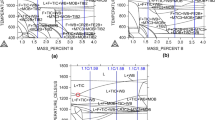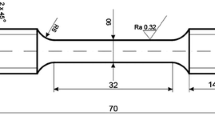Abstract
Comparison of the results obtained from studies of the effect of boron microadditives on the structure and properties of liquid melts and of the alloys crystallizing out of such melts indicates that the reactions between boron and other highly active surfactants such as oxygen’ sulfur’ phosphorus’ nitrogen’ and carbon must be taken into account when determining the optimum amount of boron to be added. Thus’ in order for boron to have a greater effect on steel structurization and properties’ the most active surfactants — oxygen and sulfur — must be removed before the boron is added to the liquid metal.
Similar content being viewed by others
References
Ya. E. Gol’dshtein and V. G. Mizin’ Modification and Microalloying of Cast Iron and Steel [in Russian]’ Metallurgiya’ Moscow (1986).
N. P. Lyakishev’ Yu. L. Pliner’ and S. I. Lappo’ Boron-Containing Steels and Alloys [in Russian]’ Metallurgiya’ Moscow (1986).
E. M. Grinberg’ Physical Metallurgy of Boron-Containing Structural Steels [in Russian]’ Izd. MISiS’ Moscow (1997).
K. A. Lanskaya’ High-Chromium Heat-Resistant Steels [in Russian]’ Metallurgiya’ Moscow (1973).
M. V. Pridantsev’ Heat-Resistant Aging Alloys [in Russian]’ Metallurgiya’ Moscow (1973).
E. G. Fel’dgandler and L. Ya. Savkina’ “Effect of boron on the properties of 03Kh17N14M3 low-carbon steel’” Kachest. Stal. Splavy’ No. 3’ 51–52 (1978).
O. V. Kasparova’ Role of Impurities in Intercrystallite Corrosion of Austenitic Stainless Steels and Development of Effective Approaches for Prevention of Such Corrosion’ Abstract of Dissertation for Doctor of Engineering Science’ NIFKhI’ Moscow (1993).
O. B. Lapshina and M. M. Nogina’ “Effect of boron and Cerium on the manufacturing and corrosion properties of KhN30MD alloy’” in: High-Quality Steels and Methods for Improving Their Operational Specifications [in Russian]’ Metallurgiya’ Moscow (1988)’ pp. 83–87.
M. D. Abramovich’ S. N. Botinov’ A. T. Poltukhovskii’ Radiation Physical Metallurgy for Nuclear Power Plants [in Russian]’ Energoatomizdat’ Moscow (1984).
D. R. Harries’ Physical Metallurgy of Fe-Cr-Ni Austenitic Steels. Mechanical Behaviour and Nuclear Applications of Stainless Steel [Russian translation]’ Metallurgiya’ Moscow (1987)’ pp. 9–34.
A. T. Poltukhovskii’ M. V. Leont’eva-Smirnova’ V. M. Chernov’ et al.’ “Development of new heat-resistant 12% chromium steel (16Kh12V2FTaR) with rapid decrease of induced radioactivity for use in Russian nuclear power’” Metallovedenie i Termicheskaya Obrabotka Metallov’ No. 11’ 60–64 (2002).
E. M. Grinberg’ Laws Governing the Structurization of Boron-Doped Alloys and Development of Production and Machining Processes for Such Alloys’ Abstract of Dissertation for Doctor of Engineering Sciences (1991).
N. P. Lyakishev (ed.)’ Phase Diagrams for Binary Metal Systems. A Handbook [in Russian]’ Mashinostroenie’ Vol. 1’ Moscow (1996)’ pp. 426–511.
C. H. P. Lupis’ Chemical Thermodynamics of Materials [Russian translation]’ Metallurgiya’ Moscow (1991).
O. Kubaschewski and S. B. Alcock’ Metallurgical Thermochemistry [Russian translation]’ Metallurgiya’ Moscow (1982)’ pp. 202–355.
S. N. Zadumkin’ “Modern theories of the surface energy of pure metals’” in: Surface Phenomena in Melts and Resultant Solid Phases [in Russian]’ Kabard.-Balkar. Izd.’ Nal’chik (1965)’ pp. 12–27.
S. N. Botinov’ V. N. Prokhorov’ V. D. Belashev’ et al.’ in: Radiation Physics of Solids and Reactive Materials [in Russian]’ Atomizdat’ Moscow (1970)’ pp. 82–94.
O. S. Bobkova and A. M. Samarin’ “Relationship between surface tension of chromium-nickel alloys and various properties of chromium-nickel alloys’” Izv. Akad. Nauk SSSR’ Otdel. Tekhn. Nauk’ No. 2’ 52–59 (1954).
O. S. Bobkova’ “Interphase surface tension in iron-chromium alloys at the interface with multi-component slag’” in: Surface Phenomena in Melts [in Russian]’ Naukova Dumka’ Kiev (1968)’ pp. 321–323.
A. I. Kolpakov’ O. S. Bobkova’ and V. S. Rutes’ “Continuous casting of chromium-nickel steels with synthetic slags’” Staleplavil’noe Proizvodstvo’ Central Research Institute for Ferrous Metallurgy (TsNIIChM)’ Series 6’ Inf. 6 (1967).
Author information
Authors and Affiliations
Additional information
__________
Translated from Metallurg’ No. 3’ pp. 56–60’ March’ 2008.
Rights and permissions
About this article
Cite this article
Bobkova, O.S., Svistunova, T.V. Impact of boron on melt properties and structurization of iron and nickel-based steels and alloys. Metallurgist 52, 175–181 (2008). https://doi.org/10.1007/s11015-008-9028-9
Published:
Issue Date:
DOI: https://doi.org/10.1007/s11015-008-9028-9




